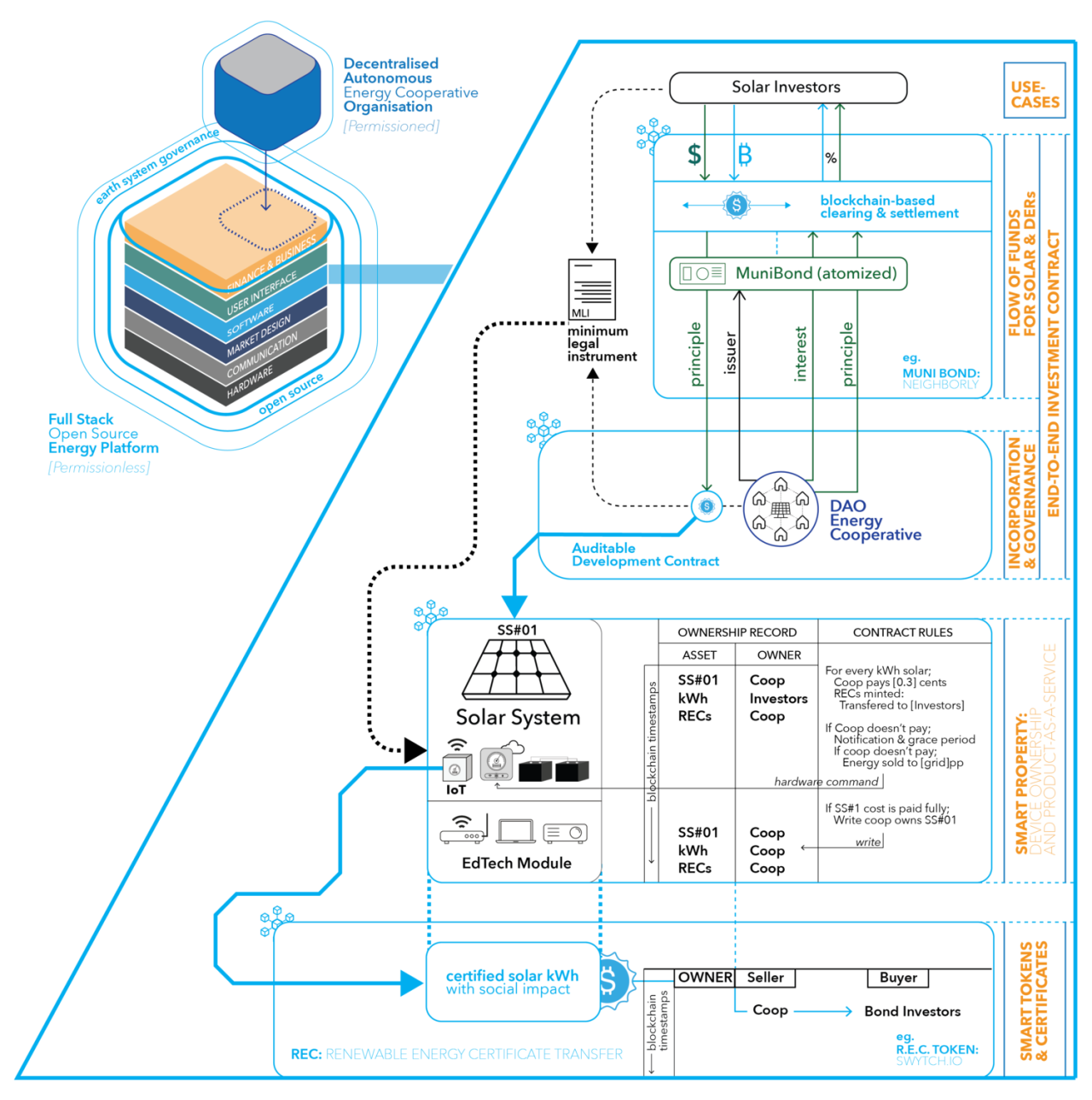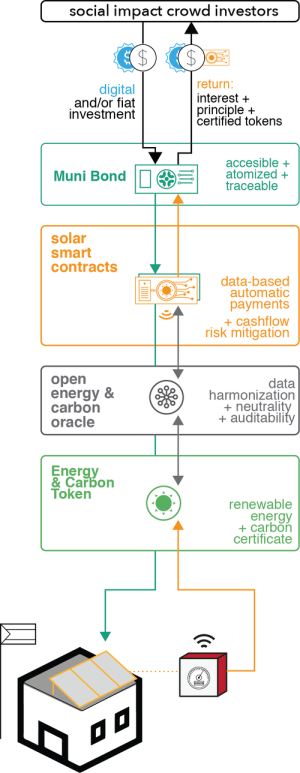Leveraging Smart Contracts for Peer-to-Peer Solar Financing in Puerto Rico

In Brief
Institutional finance and traditional sources of capital for renewable energy are limited in scope and application. Smaller, distributed solar PV and battery storage systems promote resiliency, sustainability and energy security, but they are not receiving the funding they need.
Blockchain-enabled smart contracts and peer-to-peer financing methodologies are being used in some settings to deploy solar PV microgrids, creating needed resiliency and community ownership.
In the wake of Hurricane Maria, Open Solar, a partnership between Yale’s openlab and MIT’s Digital Currency Initiative, is pursuing open source, smart-contract microgrid financing in Puerto Rico.
Financial mechanisms such as the traditional power purchase agreement (PPA) and the Investment Tax Credit (ITC) have de-risked the value proposition for renewable energy investment, in particular for utility-scale wind and solar photovoltaics (PV). These mechanisms, among others, have attracted capital from large-scale institutional investors with long-term horizons, low risk tolerance and high tax liability.
Although these tools have undoubtedly played a role in accelerating the clean energy transition, there are still large gaps in financing, especially around smaller-scale projects and microgrids. According to Bloomberg New Energy Finance, in 2017 there was $279 billion in total global renewable energy investment. Utility-scale renewables backed by institutional finance represented $215 billion whereas only $49.4 billion in capital was deployed for small, distributed capacity. The high soft costs — such as legal fees and permitting — and the rigid project finance requirements surrounding ownership and liability narrow investment opportunities for smaller-scale projects.
A new mechanism offers possibilities for addressing these barriers. “Smart” contracts leverage blockchain technology to streamline and automate many of the most technical and time-consuming financial and logistical steps. Furthermore, smart contracts integrate peer-to-peer financial mechanisms, tapping into new capital pools for small and distributed renewable systems.
Rebuilding after Hurricane Maria
Microgrids receive only a fraction of current solar capital, but they may need to play a key role in our future energy grid.
Natural disasters highlight the need for more decentralized and resilient clean energy, damaging centralized energy infrastructure and causing blackouts. A recent example was Hurricane Maria, which in 2017 devastated much of Puerto Rico’s energy infrastructure. The resulting damage left some without power for close to a year following the storm. Even today, there are ongoing political and financial delays in rebuilding generation and transmission centers on the island. Singularly interconnected generation and load centers led to the spread of the power outage during the storm.
The Puerto Rican government is aware of the liabilities of redesigning the local electricity system as it was, with high voltage transmission lines transporting mostly fossil-fuel-based electricity across the island to disparate load centers. Traditional investors are also wary to redeploy the same types of capital in a region exposed to a disproportionate share of extreme weather. As private developers explore alternative rebuilding strategies, Puerto Rico has proposed regulation and oversight of solar-based microgrid development. The Puerto Rico Electric Power Authority has even created an “Integrated Resource Plan” that segments the island into different microgrid domains, using distributed solar PV and storage as turnkey technologies.
The oversight of the Puerto Rican government has begun to drive momentum toward renewable energy. However, the novel nature of solar- and storage-based microgrid technologies and their incongruences with the current investment landscape still beckon for more new financial structures to accelerate their adoption on the island and beyond.
Understanding Smart Contracts and Peer-to-Peer Financing
Peer-to-peer financial structures are beginning to be leveraged to finance smaller-scale distributed generation. The ability for smaller, more agile and less institutionalized forms of capital to participate in the process vastly increases the funding opportunities available for projects.
However, attracting multiple streams of capital to simultaneously fund a solar microgrid project increases complexity and transaction costs. To allocate risk and revenue to a larger group of investors and stakeholders, projects need to track energy output and other elements such as production of renewable energy certificates (RECs) in detail.
“Smart” contracts solve this problem by streamlining the intermediary processes between initial investment, contracting and system deployment. Smart contracts leverage blockchain to create an immutable, decentralized and encrypted ledger.
Core functions of smart contracts for solar include:
- Intermediating supporting logistics for initial investment, system deployment and contractor maintenance
- Executing payments between “wallets” that hold blockchain energy currency
- Validating the liquidity of wallets and managing breach repercussions
- Allocating and changing ownership of system components based on payments
- Generating, transferring and tracking RECs.
These functions cannot be achieved without accurate, granular data streams. Smart meters are therefore a key component of smart contracts, and essential for robust energy data processing and integration with financial and performance data. The declining cost of smart meters over the past decade has made this internet-of-things solution affordable and actionable.
The three key virtues of these blockchain-based systems — immutability, decentralization and encryption — ensure that transactions are accurate and that data flows are protected for all stakeholders. Immutability establishes permanent and accurate records. Decentralization facilitates ownership of and responsibility over the financial process. It bypasses the need for a centralized microgrid governing system, which can be expensive and create additional rigidity and bureaucracy. Encryption protects transaction anonymity and ensures the level of cybersecurity necessary for an investment-grade operation.
The Yale Open Innovation Lab (openlab) has pioneered an open source “smart” contract system for community-owned microgrid financing. The openlab is a partnership between the Tsai Center for Innovative Thinking and the Yale Center for Business and the Environment and focuses on leveraging radical collaboration, multi-stakeholder networks and emerging technology to address global challenges.
Figure 1 illustrates the high-level project finance overview of openlab’s smart contract and systems architecture for a solar PV system.
Smart contracts and other blockchain-enabled technologies are increasing in prevalence in the energy sector. The Energy Web Foundation, eMotorWerks and Spectral Energy have piloted blockchain-based solutions. The Energy Web Foundation and Spectral Energy have created peer-to-peer transactive electricity networks, and eMotorWerks has developed a smart charging network which allows for sharing between electric vehicles and charging station owners.
Applications for Resiliency and Community Ownership
Open Solar, a partnership between Yale’s openlab and MIT’s Digital Currency Initiative, is pursuing open source, smart-contract microgrid financing in Puerto Rico. Puerto Rico’s government has established select schools as emergency centers, and has set targets for the first 100 schools to deploy robust energy and communication centers so that they can be better equipped to manage future disasters. By endowing the schools with solar PV microgrids, the Open Solar platform seeks to help these communities achieve emergency readiness while also securing more affordable energy. Investment instruments analyzed for this program a municipal bond, which impact investors would design and purchase through the blockchain-enabled platform. Various smart meters and internet of things devices stream data for the smart contracts.
Up-front costs can be a prohibitive obstacle for smaller investors. However, the bond would require zero down payment. Furthermore, soft costs associated with microgrid permitting and data operations are mitigated through the smart contract architecture. Figure 2 from Open Solar illustrates the steps from financing the system to generating and tracking energy as well as RECs and other carbon certifications.
This solution has received endorsement from the Puerto Rican government and the secretary of education. It has successfully been implemented in the school district of Aibonito, Puerto Rico. Now, the MIT-Yale collaboration is preparing a project finance document for retrofitting 700 schools across the Puerto Rican territory with localized smart-grids.
“The vision of Open Solar is to create an open source platform and to help Puerto Rico take control of their energy autonomy,” said Martin Wainstein — Yale openlab founder and Open Solar product architect — in a 2018 webinar.
It is particularly fitting that this new financial structure is being developed in Puerto Rico for reasons beyond disaster relief. Puerto Rico has among the highest electricity prices in the United States. The high cost of electricity on the island derives in part from debt repayment and the cost of rebuilding infrastructure. High electricity rates can be especially burdensome for lower income populations. Decreasing reliance on centralized grid infrastructure through smart solar investment offers a way to increase resiliency and also welfare.
Paths Forward
Crowdfunding and peer-to-peer finance are not new phenomena. Companies such as Kickstarter, Indiegogo and GoFundMe have excelled at mobilizing untapped capital pools for entrepreneurship and fundraising. Regulation Crowdfunding, a variant of traditional crowdfunding that enables eligible companies to buy and sell equity securities, can help investors to connect with projects like Open Solar. Although slightly different than the municipal bonds expected to be at play in current applications in Puerto Rico, Regulation Crowdfunding represents a more standardized and replicable form of peer-to-peer finance for distributed resources.
“The highest and best use of Regulation Crowdfunding is democratized ownership of distributed resources,” said Matthew Moroney, co-founder and COO of Raise Green, a platform that specializes in Regulation Crowdfunding for social- and environmental-impact-oriented projects. Moroney argues that because blockchain faces regulatory uncertainty, Regulation Crowdfunding offers a reliable way to test the ideas of smart contracts and fractionalized asset ownership for distributed energy.
According to Moroney, challenges for Regulation Crowdfunding “include the cap of the annual raise ($1.07M) and the complexities of corporate structures, legal filings, and risk,” he wrote in an email. “The biggest restriction [facing project finance] is the contracting complexities and frictional legal costs, which create a market problem: a shortage of investable projects,” he said.
The SEC is currently performing its mandatory review of Regulation Crowdfunding this year, which is an opportunity for the regulations to evolve along with the industry. As structures like Regulation Crowdfunding continue to develop, they stand to bring greater opportunities for smart contracts to streamline project development and catalyze new distributed energy generation.
Note: Yale openlab is a partnership between the Tsai Center for Innovative Thinking and the Yale Center for Business and the Environment.
To comment on this article, please post in our LinkedIn group, contact us on Twitter, or use our contact form.

